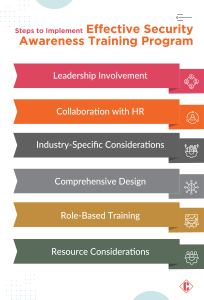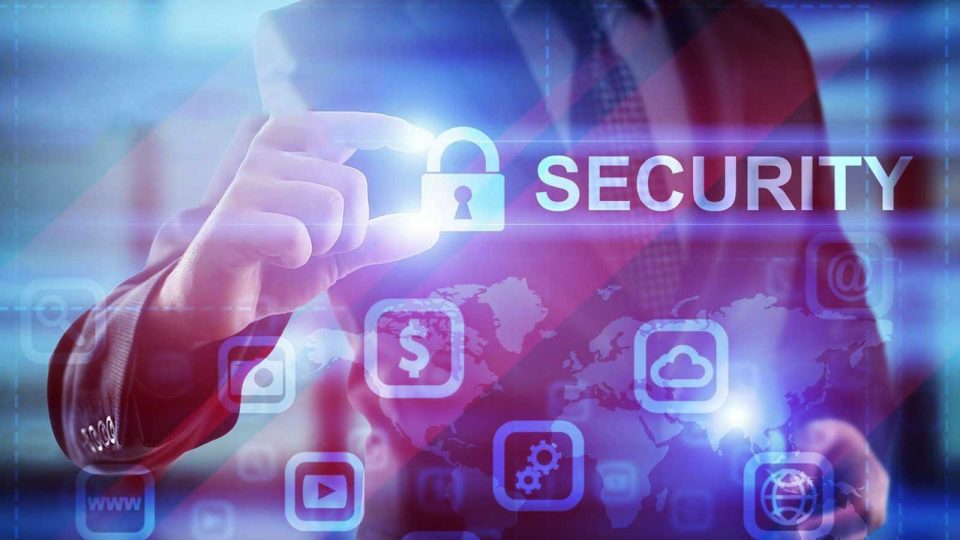Cybersecurity remains a top priority for organizations, with the pandemic adding complexity to these concerns. The hybrid office model, as highlighted presents both opportunities and challenges for companies and cybercriminals.
Addressing these evolving concerns requires more than isolated initiatives. Raising awareness and changing ingrained employee attitudes necessitate a strong security culture. This article explores strategies tailored for CIOs to foster a culture of security awareness, recognizing its pivotal role in mitigating contemporary cybersecurity threats.
What is Security Awareness?
Security Awareness is the amalgamation of knowledge and attitudes within an organization concerning the safeguarding of both physical and electronic information assets.
It signifies an acknowledgment that there exists a potential threat where individuals may intentionally or unintentionally compromise, damage, misuse, or abuse protected data stored within our computer systems and across our organizational framework. It is crucial to proactively fortify the information assets – encompassing physical, electronic, and personal aspects – by preemptively mitigating these threats.
Evolution of Security Awareness: A Concise History
The roots of cybersecurity trace back to the early Internet era. In the 1980s, the surge in the popularity of the World Wide Web witnessed cyber threats, exemplified by the 414s group hacking into 60 computers across various institutions. This catalyzed the formulation of the Computer Fraud and Abuse Act.
Concluding the 1980s, Robert Morris executed the first significant worm attack, exposing the internet’s vulnerability and leading to the establishment of Computer Emergency Response Teams (CERTs). This incident marked a pivotal moment in advancing the concept of preventative cybersecurity.
Moving into the 1990s, hacking attempts persisted, primarily targeting government agencies and large corporations due to limited internet usage. However, mainstream users felt the threat in 1997 when hackers targeted Yahoo!, issuing false claims of a “logic bomb” threat unless Kevin Mitnick was released.
In 1998, the Bureau of Labor Statistics faced a notable spamming incident, prompting the U.S. Justice Department to launch the National Infrastructure Protection Center, aimed at shielding key national systems from cyber threats.
Why is it Important to create a culture of Security Awareness?
Recent figures reveal the importance of comprehensive training when analyzing the security awareness landscape.
- Human Element in Data Breaches: In 2023, 70% of data breaches involved the human element. This underscores the critical need for heightened security awareness among employees to mitigate such vulnerabilities, as per Verizon’s report.
- Cost Implications: The average cost of a data breach reached an all-time high of just under $4.35 million in 2022. Investing in security awareness training is crucial for minimizing the financial impact of data breaches.
- Gap in Cybersecurity Programs: Alarmingly, only 1 in 9 businesses (11%) extended cybersecurity awareness programs to non-cyber employees in 2020 according to the Cybersecurity Skills Report. Bridging this gap is imperative for holistic organizational security.
- Prevalence of Phishing Attacks: 1 in 3 data breaches involves phishing. Implementing robust security awareness training equips employees with the knowledge to identify and thwart phishing attempts, reducing the risk of data compromise.
- Security Challenges with Remote Work: The shift to remote work has brought about security challenges, with 20% of organizations facing a security breach attributed to remote workers, according to Malwarebytes. Vital security awareness training becomes a frontline defense against threats emerging from remote work scenarios.
Organizations must prioritize and invest in security awareness training to fortify their defenses, reduce vulnerabilities associated with the human element, and safeguard against the escalating costs and risks of data breaches.
How to Create a Culture of Security Awareness?
1. Instill the concept that security belongs to everyone
In fostering a sustainable security culture, recognize that security is a collective responsibility. Align your vision and mission to emphasize the non-negotiable nature of security, involving all levels of staff, from executives to frontline personnel.
2. Focus on awareness and beyond
Implement creative approaches to security awareness, moving beyond traditional methods. Tailor programs to different regions, departments, and roles to embed security into the organizational story. Extend awareness efforts to encompass application security knowledge for developers and testers, turning crises into teachable moments.
3. Implement a secure development lifecycle (SDL)
Establish a Secure Development Lifecycle (SDL) as the foundational process for a sustainable security culture. SDL includes security requirements, threat modeling, and security testing activities. Consider housing the SDL within a product security office and invest in this consultancy to teach engineering the depths of security.
4. Reward and recognize those who prioritize security
Celebrate successes in security awareness programs, offering tangible rewards for completion. Consider cash incentives, identifying the significant return on investment in preventing data breaches. Provide opportunities for career growth in security roles and sponsor advanced degrees in cybersecurity, demonstrating a commitment to security culture.
5. Build security community
Foster a security community within the organization, uniting advocates, the security-aware, and sponsors. Create an interest group focused on security, encouraging one-on-one mentoring, regular meetings, or even an annual conference to share knowledge and skills.
Security Awareness Training Software
KnowBe4 Security Awareness Training
Hoxhunt
MetaCompliance Security Awareness Training
SoSafe
Arctic Wolf
Essential Components of Robust Security Awareness Training
A robust security awareness training program should cater to individuals with diverse technical aptitudes, cybersecurity knowledge, and learning preferences within the workforce.
Multifaceted Approach:
Engage all employees through a diverse range of lessons and learning opportunities. Ensure inclusivity by providing role-based content tailored to the specific needs of different positions, including third-party stakeholders.
Key Components:
-
- Educational Content: Deliver comprehensive content in various formats, including written material, interactive online learning, and gamification sessions. Adapt complexity levels to suit different roles within the organization.
- Follow-up and Ongoing Messaging: Reinforce cybersecurity policies through regular reminders. Provide concise refreshers on identifying and avoiding security risks, handling potential issues, and staying informed about emerging threats.
- Simulated Attack Testing: Assess workforce adherence to cybersecurity policies through simulated attack testing, implementing phishing attempts, social engineering tactics, surveys, quizzes, and other assessments.
- Worker Involvement Reporting and Measurement: Monitor the effectiveness of the training program, identifying weaknesses and areas requiring improvement. Establish a feedback loop to enhance the overall awareness strategy.
- Compliance-Specific Requirements: Ensure employees are well-informed about specific compliance requirements, including standards like the Health Insurance Portability and Accountability Act and Payment Card Industry Data Security Standard.
Diverse Training Methods:
Implement a mix of formal education, informational learning opportunities (such as weekly emails containing tips and updates), and experiential sessions, including gamification and simulations.
How to Implement an Effective Security Awareness Training Program?

- Leadership Involvement: The Chief Information Security Officer (CISO) and the cybersecurity team should take the lead in crafting the program. Collaboration with other executives is crucial to garner support and address the most significant risks aligned with the cybersecurity strategy.
- Collaboration with HR: The CISO should collaborate with the Human Resources (HR) department, typically responsible for workplace training, to ensure a well-formed and effective security awareness program.
- Industry-Specific Considerations: Those developing the program should incorporate industry-specific threats that organizations face. Recognizing these variations is essential, given the diverse threat landscape across different sectors.
- Comprehensive Design: Design a program that progresses from fundamental to advanced materials. Include an assessment process to determine each worker’s level of cybersecurity awareness, allowing for the creation of personalized learning pathways.
- Role-Based Training: Tailor the training program to consider the risks and threats associated with various roles of the organization. Recognize that employees in different positions encounter distinct cybersecurity challenges.
- Resource Considerations: Larger organizations may leverage their significant HR departments to develop and deliver awareness training programs. Alternatively, many opt to outsource some or all of the training for efficiency and effectiveness. Regardless, mechanisms should be in place to measure training effectiveness at enterprise and individual employee levels.
Conclusion
In conclusion, as Cybercrime Magazine forecasts a staggering annual loss of nearly $10.5 trillion due to cybercrime by 2025, equivalent to $19,977,168 per minute, the imperative for a robust cybersecurity culture becomes paramount. Securing information, assets, and reputation requires a comprehensive approach, and businesses can foster a security-centric work culture through inclusiveness, embedding security into the organizational vision, and ensuring every member recognizes their role. Regular training initiatives covering phishing identification, password management, and data protection are crucial. Continuous communication through various channels, including emails, newsletters, posters, and intranet portals, keeps staff informed and vigilant. Establishing a Security Development Lifecycle (SDL) guides security practices in software and system development while designating security champions enhances peer education and awareness. Recognizing and rewarding individuals excelling in security practices through incentives contributes to a positive and motivated security culture within the organization.
FAQs
1. How can organizations promote security awareness?
Organizations can promote security awareness through regular training programs, creating a culture of inclusiveness, providing resources for ongoing education, and implementing communication strategies to keep employees informed about the latest security updates.
2. What topics should be covered in security awareness training?
Security awareness training should cover a range of topics, including identifying phishing attempts, creating and maintaining secure passwords, understanding social engineering tactics, recognizing malware threats, and adhering to organizational security policies.
3. How often should security awareness training be conducted?
A5: Regular and ongoing security awareness training is essential. Conducting sessions at least annually, with additional targeted training for specific threats or changes in the threat landscape, is recommended.
4. How can individuals contribute to a security-centric culture?
A6: Individuals can contribute by staying informed about security best practices, promptly reporting any suspicious activities, participating in training programs, and being proactive in maintaining a secure work environment.
5. What is the role of leadership in promoting security awareness?
A7: Leadership plays a crucial role in promoting security awareness by incorporating security into the organizational culture, providing necessary resources for training, and leading by example in adhering to security policies.
[To share your insights with us as part of editorial or sponsored content, please write to sghosh@martechseries.com]


